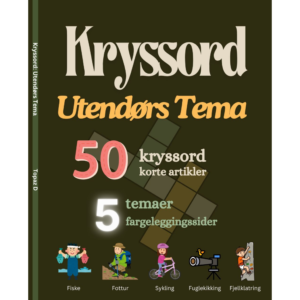
Explore & Play
Discover interesting topics and solve the accompanying crossword puzzle.
Waste Crossword | Lifecycle of Waste and Waste Management
Table of Contents
At the beginning of this blog post, you’ll find the waste crossword puzzle. Feel free to play it first and then dive into the article to expand your knowledge. If you’re not too familiar with the topic, you can start by reading the article to get some background information, and then return to the crossword to test your understanding.
Waste Crossword
You can either fill in the crossword puzzle directly on this page or click the button in the bottom right corner to print it for free.

The Lifecycle of Waste: From Creation to Recycling
Waste is a natural part of our daily lives, but understanding how it is managed—from creation to recycling—can help us make better choices to reduce its impact on the environment. By exploring the lifecycle of waste, we gain insight into how different types of waste are handled, recycled, or disposed of. In this article, we will break down the waste management process and discuss how individuals can contribute to a more sustainable future.
The Importance of Waste Management
Waste management is not just a matter of throwing things away; it’s a crucial part of ensuring the health of our planet. As global waste production continues to rise, effective waste management systems have become more essential than ever. Proper management helps reduce pollution, conserves resources, and minimizes the environmental impact of waste.
By understanding the lifecycle of waste—from its creation to its final disposal or recycling—we can all contribute to making better, more informed choices about how we handle waste in our own lives. In fact, taking steps toward reducing waste can significantly decrease the strain on landfills and help lower our carbon footprints. In this article, we’ll explore the different types of waste and how they are managed.
Pro Tip: Don’t forget to check out the crossword puzzle at the end of the article, which features key waste-related terms!
Different Types of Waste
Organic Waste
Organic waste refers to materials that come from living organisms, such as food scraps and garden waste. These items are biodegradable and, when properly disposed of, can be transformed into nutrient-rich compost for soil.
Food waste is a significant contributor to global waste production. When food is thrown away, it not only wastes valuable resources but also contributes to landfill overflow. Composting food scraps and garden waste, however, is an excellent way to keep these materials out of the trash. By turning organic waste into compost, you help reduce the burden on landfills while creating a valuable resource for gardening.
Recyclable Waste
Materials like paper, plastic, glass, metal, cardboard, and scrap metal fall under the category of recyclable waste. These materials can be processed and turned into new products, reducing the need for raw materials and minimizing the environmental impact of manufacturing.
Recycling paper and cardboard helps save trees and energy. Plastic, though more challenging to recycle, can also be processed into new products, reducing pollution in our oceans and landfills. Glass and metal are highly recyclable, and when done correctly, the recycling process has a minimal environmental footprint.
E-Waste
E-waste, or electronic waste, includes discarded electronics such as computers, phones, televisions, and household appliances. Due to the rapid rate at which technology changes, many electronics are quickly outmoded and replaced, contributing to large volumes of waste.
Because e-waste contains valuable metals like gold, copper, and silver, it can be recycled for these materials. However, e-waste is often filled with hazardous substances like lead, mercury, and cadmium. Therefore, it’s crucial to dispose of e-waste responsibly. Specialized recycling facilities can extract reusable components from old electronics and dispose of hazardous materials safely.
Hazardous Waste
Hazardous waste includes any waste that is dangerous or potentially harmful to human health and the environment. Examples include chemicals, paint, oil, batteries, and medical waste. Improper disposal of hazardous waste can lead to severe environmental damage, contaminating soil and water and harming wildlife.
Certain types of hazardous waste, such as batteries and paint, require special handling to ensure they don’t cause environmental harm. Proper disposal methods include dropping them off at designated recycling centers or hazardous waste collection points. By following these procedures, we can help minimize the risks associated with toxic waste.
Bulky Waste
Bulky waste refers to large items that are typically difficult to dispose of in regular waste collection bins. This includes old furniture, appliances, tires, and other large household items. Disposal of bulky waste often requires special pickup services or drop-off at designated locations.
Properly handling bulky waste is essential to avoid clogging landfills with items that could be recycled or repurposed. For example, old appliances may contain valuable metals like copper and aluminum, while furniture can be refurbished or donated to extend its lifespan.
Medical and Other Specialized Waste
Medical waste includes anything generated in the healthcare industry that could potentially be contaminated with infectious materials. Items like syringes, bandages, and expired medications all fall under this category. Specialized disposal methods are required to ensure these materials don’t pose a risk to public health.
Other types of specialized waste, like shredded paper and broken glass, also require specific disposal. While shredded paper can often be recycled, it should be separated from other recyclable materials to avoid contamination. Similarly, broken glass needs to be handled carefully to prevent injury and should be disposed of in special containers designed for this purpose.
The Waste Lifecycle: From Creation to Disposal
Creation of Waste
The creation of waste starts the moment products are used and disposed of. Every day, we generate waste from packaging, food preparation, clothing, and other daily activities. Some of these items, like plastic packaging and disposable clothing, are single-use and contribute to a large portion of waste generated worldwide.
The production of waste starts when we purchase products. Whether it’s food that ends up as food waste or packaging that becomes cardboard and plastic waste, our consumption habits directly affect the amount of waste we generate. Understanding where our waste comes from is the first step in reducing it.
Tip: Being mindful of packaging and opting for reusable items can significantly reduce waste at the point of creation.
Collection and Transportation
Once waste is generated, it’s collected and transported to sorting facilities, recycling centers, or disposal sites. In some cases, bulky waste like tires and furniture requires special handling, which can add complexity to the collection process.
In the case of medical waste or hazardous waste, special transport methods are used to ensure safe delivery to treatment facilities. Waste management services also ensure that items like appliances and electronics are processed at specialized facilities, keeping dangerous components out of landfills.
Recycling and Reuse
Recycling is one of the most effective ways to reduce waste and conserve resources. Materials like metal, glass, plastic, and paper can be recycled and repurposed into new products. In fact, recycling reduces the need for raw materials and cuts down on energy consumption, making it an environmentally friendly solution.
For example, scrap metal can be melted down and used in the production of new metal goods, while wood can be reused in construction or furniture manufacturing. Glass can be endlessly recycled, reducing the need to mine raw materials. As consumers, it’s our responsibility to recycle properly to ensure these materials are used to their full potential.
Composting
Organic waste, like food scraps and garden waste, can be composted to create rich, fertile soil. Composting is a sustainable way to manage organic waste because it not only keeps it out of landfills but also provides a valuable resource for gardening and landscaping.
Composting at home is easy, and it can significantly reduce the amount of waste we send to landfills. In fact, by composting food scraps, we can divert a large portion of our organic waste and turn it into something useful.
Landfill and Incineration
When waste can’t be recycled or composted, it is typically sent to landfills or incinerated. While landfills are the most common form of waste disposal, they have several drawbacks. For example, landfills can release harmful gases into the atmosphere and may take up valuable land space.
Incineration, on the other hand, involves burning waste to reduce its volume. While it can help manage large amounts of waste, it also produces air pollution and requires proper filtration systems to minimize environmental harm.
Special Considerations in Waste Management
Disposing of Hazardous Materials
Certain waste materials, such as batteries, oil, and paint, pose unique challenges due to their toxic properties. It’s essential to follow proper disposal methods for these items to prevent them from contaminating the environment. Many communities have designated collection points for hazardous waste, making it easier to dispose of these materials safely.
Managing Bulky Waste
Items like furniture, appliances, and tires need to be managed separately to ensure they are properly recycled or disposed of. Bulky waste often requires special collection services, but many items can be repurposed, refurbished, or donated to extend their life.
E-Waste Recycling
Electronics like old phones, computers, and compact discs contribute significantly to the global waste problem. Because e-waste contains valuable metals and harmful chemicals, it’s important to dispose of electronics responsibly. Specialized recycling programs can recover valuable components while safely handling toxic materials.
How You Can Help Reduce Waste
Recycling at Home
Recycling at home is one of the easiest and most effective ways to reduce your environmental footprint. By sorting materials like paper, glass, plastic, and metal, you can ensure they’re sent to the right recycling facility. Additionally, consider recycling batteries, clothing, and even food waste when possible.
Reducing Consumption
Reducing consumption is another powerful way to reduce waste. Choose products with minimal packaging, and opt for reusable alternatives like cloth bags and water bottles instead of single-use plastics.
Composting and Reusing
By composting organic materials and reusing items whenever possible, you can significantly reduce the amount of waste that ends up in landfills. For instance, you can compost food waste or repurpose items like old clothing or containers to keep them out of the trash.
Key Takeaways
By understanding the lifecycle of waste, from creation to disposal or recycling, we can make better decisions to reduce waste, conserve resources, and protect the environment. Through simple actions like recycling, composting, and reducing consumption, we can all play a part in ensuring a cleaner, healthier planet.
Ready to test your knowledge on waste management? Play the crossword puzzle at the end of the article!
Share to...
I hope you enjoy the content.
Want to receive our daily crossword puzzle or article? Subscribe!
You may also be interested in
Share to…
Want to receive our daily crossword puzzle?
-
Jigsaw Puzzles
Maine Coon Cat Ink Wash Puzzle 250 | 300 | 500 Pieces
kr 348,00 – kr 439,00Price range: kr 348,00 through kr 439,00 Select options This product has multiple variants. The options may be chosen on the product page -
Jigsaw Puzzles
Nordkapp Abstract Art Jigsaw Puzzle 250 | 300 | 500 Pieces
kr 348,00 – kr 439,00Price range: kr 348,00 through kr 439,00 Select options This product has multiple variants. The options may be chosen on the product page -
Jigsaw Puzzles
Chinese Dragon Jigsaw Puzzle – Zodiac Series Art 250 | 300 | 500 Pieces
kr 348,00 – kr 439,00Price range: kr 348,00 through kr 439,00 Select options This product has multiple variants. The options may be chosen on the product page

















